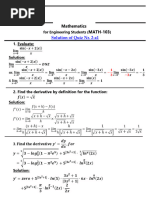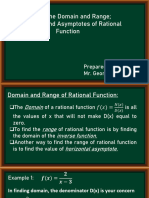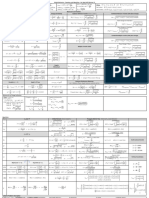Phys101, Quiz 1 Solution 28 September 2020: (A) (80 PTS.) If A Vector
Uploaded by
hselPhys101, Quiz 1 Solution 28 September 2020: (A) (80 PTS.) If A Vector
Uploaded by
hselPhys101, Quiz 1 SOLUTION 28 September 2020
Solve the following question on an A4 paper, take a picture, convert into PDF and upload to
MOODLE as the assignment of the week on PHYS 101 course of your section. Make sure that your
solution is readable. Display an outline of your work, do not write answer only.
(a) (80 pts.) If a vector "𝑪⃗ is perpendicular to both "𝑨⃗ and "𝑩
"⃗ then, "𝑪⃗ ∙ "𝑨⃗ = 0 and "𝑪⃗ ∙ "𝑩
"⃗ = 0.
Given,
"⃗ = √3,̂ + 𝒌
𝑨 0
""⃗ = −2,̂ + 3̂ − √3𝒌
𝑩 0
"𝑪⃗ ∙ "𝑨⃗ = 𝐶5 𝐴5 + 𝐶7 𝐴7 + 𝐶8 𝐴8 = √3𝐶5 + 𝐶8 = 0
"⃗ ∙ 𝑩
𝑪 ""⃗ = 𝐶5 𝐵5 + 𝐶7 𝐵7 + 𝐶8 𝐵8 = −2𝐶5 + 𝐶7 − √3𝐶8 = 0
The first equation gives √3𝐶5 = −𝐶8 and using this in the second equation we get:
1
𝐶5 = −𝐶7 = − 𝐶8
√3
Since "𝑪⃗ should be a unit vector:
𝐶5 ; + 𝐶7 ; + 𝐶8 ; = 1
Combining these last two equations:
𝐶5 ; + 𝐶5 ; + 3𝐶5 ; = 1
< < √>
If you choose the positive solution, 𝐶5 = and it gives 𝐶7 = − and 𝐶8 = − . Then,
√= √= √=
1 1 √3 0
"⃗ =
𝑪 ,̂ − 3̂ − 𝒌
√5 √5 √5
A second unit vector perpendicular to both "𝑨⃗ and "𝑩"⃗ would simply be "𝑪⃗@ = − "𝑪⃗ :
1 1 √3 0
"⃗@ = −
𝑪 ,̂ + 3̂ + 𝒌
√5 √5 √5
""⃗ and 𝑩
(b) (20 pts.) The vector product of 𝑨 ""⃗ is:
,̂ 3̂ 0
𝒌
""⃗ × 𝑩
𝑨 ""⃗ = B √30 0 = −,̂ + 3̂ + √3𝒌
1 B = (0 − 1),̂ − (−3 + 2)3̂ + E√3 − 0F𝒌 0
−2 1 −√3
The resultant of a vector product is perpendicular to both of the vectors involved in the
product, hence any vector that is parallel (or anti-parallel) to the resultant is also
perpendicular to these vectors. Since √5(−𝑪 "⃗) = −,̂ + 3̂ + √3𝒌 0 , "𝑪⃗ is anti-parallel to "𝑨⃗ × "𝑩
"⃗
and since √5(𝑪 0 , "𝑪⃗@ is parallel to "𝑨⃗ × "𝑩
"⃗′) = −,̂ + 3̂ + √3𝒌 "⃗. Then both are perpendicular to
"𝑨⃗ and "𝑩
"⃗ .
You might also like
- AP Physics Uniformly Accelerated Motion LabNo ratings yetAP Physics Uniformly Accelerated Motion Lab2 pages
- PEP 2021 Phase 1 Selection Test 2 - SolutionNo ratings yetPEP 2021 Phase 1 Selection Test 2 - Solution8 pages
- Mathematics Gist Complex Number CLASS XINo ratings yetMathematics Gist Complex Number CLASS XI6 pages
- PROBLEM 3. Derivation of Solution of Boundary Layer EquationsNo ratings yetPROBLEM 3. Derivation of Solution of Boundary Layer Equations6 pages
- In The Name of Allah, The Kind, Most Merciful, Most GraciousNo ratings yetIn The Name of Allah, The Kind, Most Merciful, Most Gracious8 pages
- INTEGRAL-CALCULUS-PRESENTATION-Version-4No ratings yetINTEGRAL-CALCULUS-PRESENTATION-Version-442 pages
- notes_key_topic_1.5_polynomial_functions_and_complex_zeros_ap_pcNo ratings yetnotes_key_topic_1.5_polynomial_functions_and_complex_zeros_ap_pc4 pages
- LECTURE - NOTES - MATH.BIJAYINI - NAYAK JhdhejNo ratings yetLECTURE - NOTES - MATH.BIJAYINI - NAYAK Jhdhej23 pages
- MVC Week 3 Lecture (Vector Equalition of Plane and Its Distance)No ratings yetMVC Week 3 Lecture (Vector Equalition of Plane and Its Distance)9 pages
- Lecture-015 Stokes Theorem Class Lecture StudentNo ratings yetLecture-015 Stokes Theorem Class Lecture Student13 pages
- Domain and Range, Intercepts, Asymptotes of Rational FunctionNo ratings yetDomain and Range, Intercepts, Asymptotes of Rational Function20 pages
- Orbital Mechanics Reference Sheets Equations and Algorithms 1689515592No ratings yetOrbital Mechanics Reference Sheets Equations and Algorithms 16895155922 pages
- 1.5 - Elementary Matrices and Finding Inverse of A Matrix-1No ratings yet1.5 - Elementary Matrices and Finding Inverse of A Matrix-114 pages
- 1.2-4 Set Theory, Relations Functions, Coordinate SystemNo ratings yet1.2-4 Set Theory, Relations Functions, Coordinate System14 pages
- Math 201 Application of Matrix: Formation of Transformation MatrixNo ratings yetMath 201 Application of Matrix: Formation of Transformation Matrix5 pages
- Student's Solutions Manual and Supplementary Materials for Econometric Analysis of Cross Section and Panel Data, second editionFrom EverandStudent's Solutions Manual and Supplementary Materials for Econometric Analysis of Cross Section and Panel Data, second editionNo ratings yet
- Edexcel GCE: 6665/01 Core Mathematics C3 Gold Level (Hard) G1No ratings yetEdexcel GCE: 6665/01 Core Mathematics C3 Gold Level (Hard) G113 pages
- To Study Law of Conservation of Angular Momentum and Its Application0% (2)To Study Law of Conservation of Angular Momentum and Its Application14 pages
- Complete Download of Solution Manual for Engineering Mechanics Dynamics 13th Edition by Hibbeler Full Chapters in PDF DOCX100% (12)Complete Download of Solution Manual for Engineering Mechanics Dynamics 13th Edition by Hibbeler Full Chapters in PDF DOCX38 pages
- Problem Set 3 Solutions: 6.849: Geometric Folding Algorithms Fall 2012 - Prof. Erik DemaineNo ratings yetProblem Set 3 Solutions: 6.849: Geometric Folding Algorithms Fall 2012 - Prof. Erik Demaine4 pages
- S Kumaresan Topology of Metric Spaces Alpha Science International LTD 2005100% (2)S Kumaresan Topology of Metric Spaces Alpha Science International LTD 2005166 pages
- Related Rates Problems: Differential CalculusNo ratings yetRelated Rates Problems: Differential Calculus10 pages
- t2 M 1685 Area of Compound Shapes Differentiated Activity Sheets Ver 8100% (1)t2 M 1685 Area of Compound Shapes Differentiated Activity Sheets Ver 86 pages
- R - Hodge To de Rham Degeneration of Nodal Cubic Curve - HeNo ratings yetR - Hodge To de Rham Degeneration of Nodal Cubic Curve - He14 pages
- Theory For Theatre Studies - (Z-Library) - 2No ratings yetTheory For Theatre Studies - (Z-Library) - 2201 pages
- The Fractal Dimension of The Lorenz Attractor lp2No ratings yetThe Fractal Dimension of The Lorenz Attractor lp25 pages
- An Illustrated Introduction to Topology and Homotopy 1st Edition Sasho Kalajdzievski - The ebook in PDF and DOCX formats is ready for download now100% (1)An Illustrated Introduction to Topology and Homotopy 1st Edition Sasho Kalajdzievski - The ebook in PDF and DOCX formats is ready for download now50 pages
- SYLLABUS DIVISION For CLASS XII MATHEMATICS BY SUDHANSU JALI SIRNo ratings yetSYLLABUS DIVISION For CLASS XII MATHEMATICS BY SUDHANSU JALI SIR6 pages

























































































